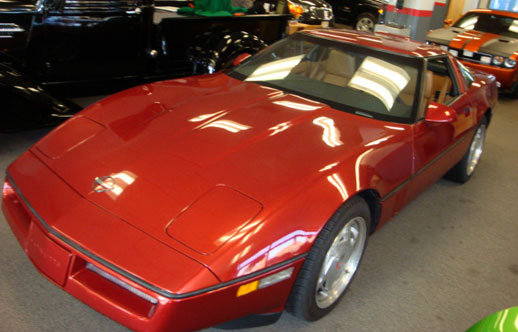1988 Chevrolet Corvette Z51 – Road Test
Taking (showroom) stock of the situation.
February 19, 2003
Nobody knows more about building and driving Corvettes for showroom stock than Bakeracing’s Kim Baker. In addition, he’s a previous 2-time National Autocross Champion. So when the opportunity arose during our Firebird testing (the track, not the car), we bundled Kim into all three Corvettes — stock 1988, 1987 Bakeracing Escort Vette and Morrison/Baker 1988 prototype — and asked him to share his thoughts with us on how each one performed:
Firebird lapping
Stock 1988 Z51 Corvette. This car cornered at higher slip angles than the two race cars, primarily because of the deeper tread on the unshaved tires. The car felt as I expected on nearly full-tread tires and was very easy to correct out of any situation. I deliberately threw the car sideways a few times to test recovery, and it proved to be easy to catch, with negligible lost of time.
The suspension was basically the same as that of the Morrison/Baker prototype, but without the bad feel to the steering or bottoming of the suspension. I would like to have tried this car with shaved 17-in. S-compound tires, as I believe that it would have outperformed the prototype on the skidpad and slalom course. With the engine, but not the gear ratios from the prototype, this car would have been very fast.
My only complaint about the suspension was that more shock damping was needed for the Phoenix track.
Bakeracing Escort Corvette. This car has a stock Z51 suspension and 16-in. S-compound Goodyears, coupled with precise and optimized alignment settings designed for Sebring. Its Bilstein shocks were valved for Sebring, and the suspension was biased for right-hand turns. The engine is a 1987 model updated to 1988 specifications, assembled to the Escort Endurance Showroom Stock regulations and exactly as raced and inspected by SCCA after its Sebring enduro 1st-place finish.
On the track the engine had a very wide power band; the suspension felt comfortable — well-balanced and easiest to drive. I could hit the apexes easily. It was difficult getting traction on the straight where the drag strip starts, but I think that was due to the track conditions early in the day. I would like to try this car with 17-in. tires.
I feel the lap times for all three cars lacked validity, because there was no opportunity for controlled comparison testing and the earliest runs were the most slippery because the track was sandy and cool. Later on, conditions did improve but the track was still slower than usual. My subjective impressions, however, would still be valid.
Morrison/Baker 1988 prototype. The gearbox ratios were not well suited to the engine or differential gearing, and as a result, the engine’s power curve could not be fully exploited.
After taking a few laps to become accustomed to the car on a race track, I found it was impossible to get the car well-balanced. If I braked into a corner, there was severe trailing-throttle oversteer. When I braked in a straight line and drove into the corner, the car would not turn in. Additionally, once into a steady-state cornering mode, the car would push, understeering even more as the power was gradually applied, then suddenly changing to oversteer. It also felt as though the suspension was occassionally riding on the bump stops.
I could tell by the way the steering felt that there was a problem with the front-suspension geometry, possibly as simple as excessive positive caster. The steering had a nonlinear, somewhat notchy feel in both the slalom and on the road course. Perhaps the car is overtricked; it needs a different setup to take advantage of the very sticky 17-in. S-compound Goodyear tires.
Slalom
Stock 1988 Z51 Corvette. This car felt very good, except for the large slip angles generated by the full-tread tires. I had to turn-in slightly earlier than I had with the race cars — four wheels sliding, and good throttle response. I used 2nd gear, as the car wouldn’t stick well enough for 3rd and the tires got a little slower toward the end of the runs.
Bakeracing No. 4. It was the easiest car to drive fast. I could almost go as fast as I could turn the wheel, but my slalom skills were too rusty to exploit the full potential of the car. No counter steering was necessary, there was very little sliding, 3rd gear worked best and the tires stayed consistent.
Morrison/Baker 1988 prototype. The steering felt odd. Third gear offered a perfect ratio for the slalom, but required a delicate balance of power to keep the rear end from sliding. I had to use the throttle to turn a fast time through the slalom, but the tires remained stable.
Read the original article here
